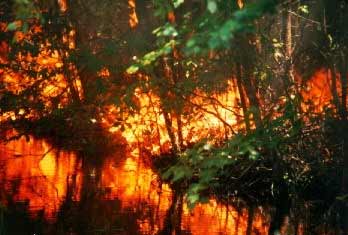|
|
|
Fire
behaviour

Bushfires are usually described by the characteristics
of the vegetation they burn. Whilst grass fires are the most
common in farming areas, bushfires are often the most threatening
to life and property. Tree growing on farms changes the characteristics
of the vegetation and therefore the way fires behave, their
intensity and how they can be controlled. Fire behaviour is
influenced by three factors:
• weather
• fuel type and arrangement
• topography.
Fire hazardous weather
Wind speed, relative humidity and temperatures
are the weather factors that have the most influence on fire
behaviour. In south-eastern Australia during summer, high fire
danger conditions develop when high-pressure systems develop
in the Tasman Sea, causing hot, dry winds to be blown from the
interior of the continent towards the coast. If a frontal depression
pushes up against the high-pressure system, wind speed can become
very strong with gusts up to 100 kilometres per hour ahead of
the change.
The rate at which a fire spreads increases dramatically with
increasing wind speed. Research suggests that if the wind speed
doubles, the rate at which a grassfire spreads might increase
three-fold. A fire’s intensity is dependent on the amount
of fuel burnt and the time taken for it to burn. So, an increase
in the rate at which the fire spreads directly increases its
intensity. The hotter the fire, the greater the damage to vegetation
and the more difficult it is to fight. Farmers cannot change
Australia’s climate. But they can anticipate a fire’s
likely behaviour and plan accordingly. For example, they can
design and manage shelterbelts and plantations so that they
reduce windspeeds and slow the rate at which a grassfire could
spread.
Fuel type and arrangement
Fuel is any material that can be burnt by
fire. Its size, moisture content, arrangement and other characteristics
influence the way the fire burns and the risk of spot fires.
Fine fuels—including grass, pine needles, leaves and bark—dry
out as the fire approaches. They then burn quickly. Coarser
fuels, such as twigs and branches, burn for longer after the
fire front has passed.
The arrangement of fine fuels is critical. Pastures trampled
by stock will burn more slowly than a standing pasture. The
more continuous the fuel, the easier it is for the fire to run,
pre-drying any fine fuels as it goes. Reducing, compacting or
separating the fine fuel component of a farm forest dramatically
reduces a fire’s intensity.
Some types of vegetation contain oils or other compounds that
increase their flammability and might allow them to say alight
for longer. Eucalyptus leaves, for example, contain oils that
vaporise as they are heated and burst into flame when ignited.
Many tree and shrub species have high moisture content in their
leaves during the fire season and are less likely to burn. When
selecting tree and shrub species farmers should consider their:
• bark type;
• leaf shape, moisture content and oil content;
• propensity to retain dry leaves or branches during the
dry season; and
• effect on the vigour and density of understorey plants
and groundcovers.
The flammability of tree foliage can be tested by holding a
green branch over a hot fire.
Topography
Ground slope directly affects the rate at
which a fire spreads. Fires travel much faster uphill than downhill
and every 10 degree increase in slope doubles the speed at which
a fire spreads. Aspect is also important because it affects
the quantity of fuel and its moisture content. North-westerly
aspects are generally the driest but may not carry a lot of
fuel.
Back to top
|
|
